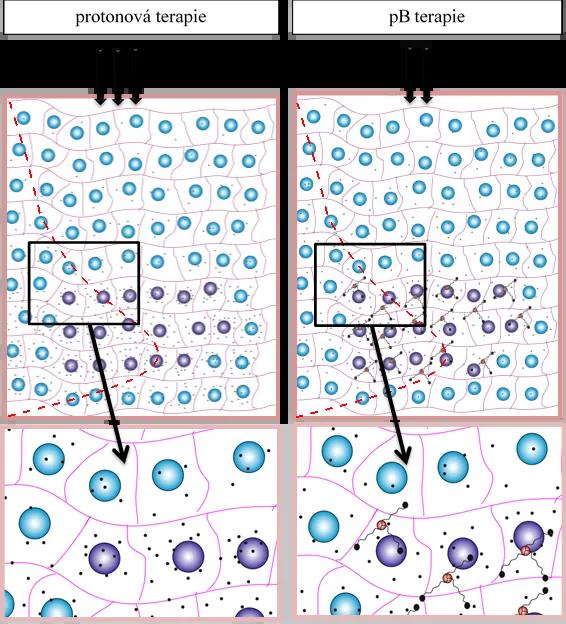The use of the Proton Boron Capture Therapy to increase the effectiveness of cancer cells destruction in proton therapy has been experimentally proven. It is the result of scientific collaboration between researchers from the Institute of Physics of the Czech Academy of Sciences (ELI Beamlines) in Prague, Laboratori Nazionali del Sud (LNS-INFN) in Catalonia, Department of Physics of the University of Naples Federico II (DoP-UoN) and Fondazione Bruno Kessler (FBK) in Trento. The research conducted in the LNS is the result of intensive two-year experimental work based on tests with different cell cultures.
Experimental technology called PBCT (Proton Boron Capture Therapy) used molecules containing boron nuclei 11B which can penetrate to a tumour located deep in the tissue. The tumour cells have increased metabolism compared to normal cells and therefore they are being absorbed by for example boron-doped glucose. These boron nuclei can then be shot with a proton beam typically used in hadron therapy. As a consequence of the interaction of one proton with one boron nucleus 11B three alpha particles with low energy (about 4 MeV) are generated. They will eventually stop at the place of a tumour where they release their energy in a single tumour cell. The macroscopic effect of this interaction is increased in biological damage to the tumour tissue in comparison with damage caused by protons only. The unused boron is then discharged from the body and it is not toxic.
“This result is scientifically and clinically very interesting because it could extend and improve the current procedures of hadron therapy. It can also have a significant social impact,” emphasised a medical physicist at the LNS, “the scientific collaboration with ELI Beamlines started several years ago by the ELIMED project.“
"The proton-boron fusion is a research branch which we have been investigating in Prague for a number of years using laser particle accelerators,” explains Daniele Margarone, a senior scientist in ELI Beamlines and she adds: „Our close scientific collaboration with INFN, UoN and FBK enabled us medical research in the LNS in Catalonia using a conventional particle accelerator. This collaboration was the key to achieving an interesting scientific result.”
The innovative PBCT method increases the relative biological efficiency of the proton therapy and at the same it maintains the unique physical properties of accelerated protons and thus it opens space for the cure of radio-resistant tumours, such as for example glioma or pancreas tumours. “Achieving this result represents an example of meaningful and successful inter-field collaboration in applied research. Such research combines expertise of different fields of science related to physics and biology and in the near future, as we hope, it will also be used in medicine,” explains Lorenzo Manti, professor at UoN.
“Medical applications of high-power lasers are important for research at ELI Beamlines. This is proven also by the joint project with the INFN laboratory called ELIMED and also the submission of the application for an international inter-field grant with the Prague Proton Centre. Further research of proton-boron therapy will be conducted there,” emphasises Georg Korn, head of research programmes at ELI Beamlines.
[1] G.A.P. Cirrone, L. Manti, D. Margarone et al., “First experimental proof of Proton Boron Capture Therapy (PBCT) to enhance protontherapy effectiveness” Scientific Reports 8 (2018) 1141, https://www.nature.com/articles/s41598-018-19258-5(link is external)
Daniele Margarone and Jan Řídký
